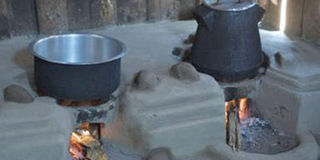How Siaya groups are countering climate change in the lake region
Sponsored by Siaya County Government

Some of the tree seedlings to be later transplanted by youth groups in Rarieda and Bondo sub-counties in Siaya county.
Youth groups in Rarieda and Bondo sub-counties in Siaya County are among the beneficiaries of a $5 million climate change resilience project. The initiative that is also being piloted in other East African countries is aimed at reducing the effects of climate change in the Lake Victoria Basin.
The selected youth groups in Siaya County will participate in activities such as soil conservation and planting of trees. In return, they will be supported to engage in income-generating initiatives of preference, such as poultry farming and others.
Siaya County Executive Committee Member (CECM) for Water, Environment and Natural CEC Charles Ogada, says the county is collaborating with the Lake Victoria Basin Commission, which is implementing the community climate change adaptation projects.
“In Siaya, the project is being piloted in three groups in Rarieda and Bondo sub-counties, where we are affected by high heat intensity. In this pilot programme, we are demonstrating technologies that can make people build resilience; for example, in water conservation,” Ogada says.
He points out that the County Government has created a community demonstration centre where people can learn and appreciate the effects of climate change and gain knowledge on how to cope.
Ogada observes that the county is witnessing unusual floods and heat of late, and attributes them to climate change.
Appreciating that Siaya County is among those that have been mapped to have low tree cover, Mr Ogada says: “As a Government, we foresee a county whose narrative will change as we increase tree cover through interventions we have been initiating. We are targeting to plant trees on hilltops and various zones. In 10 years to come, Siaya’s micro-climate will be quite different,” he declares.
He continues: “At the national platform, we are aware that the Ministry of Finance has also drawn some funding, which targets climate actions across the country. We have prepared five proposals for the same.”
Bernard Odhiambo, patron of two youth groups (Mariwa and Korengo) involved in the planting and selling of tree seedlings in Ngiya, Alego Usonga Sub-County, says they get their seedlings from Siaya Honey Producers and Processors Co-operative Society, which has partnered with the county government.
Odhiambo says the seedlings are usually ready within three to four months for sale. The groups focus on both indigenous and exotic tree seedlings.
“The co-operative has really been of great assistance when it comes to seedlings. They have made our work easy. At some point, we also give back to our community by offering indigenous seedlings for free. This is our way of ensuring we improve tree cover in our county. The free seedlings are given to churches and schools,” he explains.
Group makes and sells improvised ‘jikos’ to save trees
Elsewhere, a group known as Sifuyo Ratado Women Group, made up of 10 members, thrives on making and promoting the use of improvised cook-stoves (jikos). They are doing so to make a living and to conserve the environment in Siaya.
The initiative that started off in 2004 after the group received training by GIZ, is just now gaining greater recognition as the reality of climate change and the need to minimise the use of firewood hits home.
Initially, the group struggled and even some members bolted. Now the remaining 10 are seeing the benefits of their resilience, as Josephine Osore, a member, explains: “We started at 28 members in 2004 after the training by GIZ. Now we are only 10 members. This project has changed our lives. It has improved our economic status.”

One type of the various energy-saving cookstoves made out of clay, by the Sifuyo Ratado Women Group in Siaya county.
Members produce the cook-stoves on a rotational basis. “Once one is done with her production and has used up all the clay, another person gets the chance to work on her order. We do it on a rotational basis, and when we are done with production, we take them to the stores and await sales,” she says.
The improvised jikos come in four designs, which the group has named Jiko Kisasa, Rocket, Jiko Smart and Jiko Uhai.
Jiko Kisasa is erected at location. It uses a maximum of two standard pieces of firewood. Rocket also uses the same.
In fact, the essence of all the Sifuyo Ratado jikos is to minimise the volume of firewood needed for cooking. They come in varying sizes.
According to Ms Osore, Jiko Smart is similar to the common ceramic cook-stove, but it has a grill inside to hold charcoal. “Jiko Smart uses little charcoal and even when the charcoal is all used up, the heat on its body can still cook,” she explains. “Jiko Uhai also uses little charcoal,” she adds.
Ms Osore points out that their objective is to ensure people shun the traditional three-stone cooking and rudimentary stoves that consume lots of firewood.
She says one of the most inspiring benefits of their initiative is that several similar groups with the same agenda have sprouted. As a result, more people are getting exposed to energy-saving jikos, while at the same time more groups are improving their incomes.
“The improved jikos preserve firewood and also do not affect health, as they enable clean cooking,” Ms Osore observes.
She notes that as demand increases, the group will need more production rooms to cope, as much as they already expanded their workspace previously through support. Plus, she adds: “We need machines, but they are expensive and we cannot afford them yet. We are still appealing for more help on this.”


